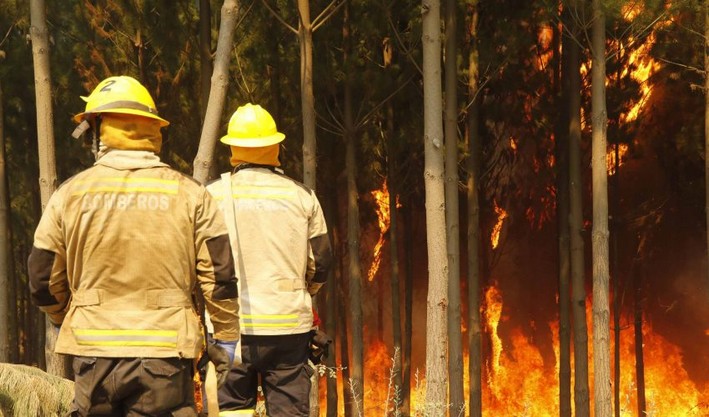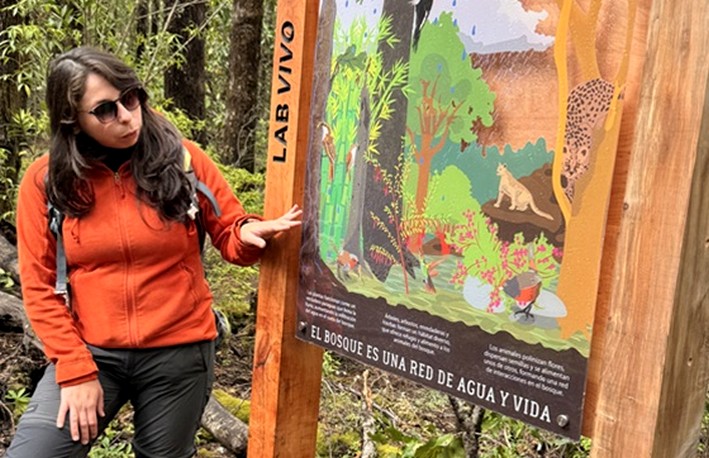James MacCarthy, Researcher: “It’s Highly Likely We’ll Continue to See an Increase in the Frequency and Severity of Wildfires”
- The specialist discusses the causes behind wildfires, their impacts, and future risks. Deforestation, the recent El Niño phenomenon, and climate change are worsening the situation.
James MacCarthy studies wildfires. As a researcher for Global Forest Watch—a satellite-based forest monitoring platform—he spends much of his time analyzing where and how fires occur. “I became interested in studying wildfires when I lived in the western United States, where there were days so smoky from fires that you couldn’t go outside,” he recalls during his conversation with Mongabay Latam about the wildfires currently raging across Latin America.
In this interview, MacCarthy notes, for example, that this year in Peru, fire alerts have more than doubled compared to the average over the past two decades. In Bolivia, he points out that the country has twice as many alerts as in previous years, while Brazil appears headed for one of its worst fire seasons this year.
His experience in forest and wildlife conservation programs also allows him to analyze, from a broader perspective, the relationship between wildfires and deforestation, the risks of worsening fires due to climate change, and the ecological impacts of fires. “Deforestation is closely linked to wildfires, so I believe there’s a strong connection between these two issues,” he explains.
Let’s start by discussing Global Forest Watch’s monitoring of heat sources and wildfires. How is it done, and what can satellite imagery tell us?
The primary source of real-time information we use at Global Forest Watch comes from various NASA satellites. We have data from the MODIS (Moderate-Resolution Imaging Spectroradiometer) sensor since 2001, giving us a long historical record. On the other hand, higher-resolution VIIRS satellites have only been operational since 2012. These two types of satellites detect heat sources on the ground—areas where temperatures are abnormally high. We’ve compiled and analyzed this data over the past 20 years, creating graphs showing expected fire trends. However, this year in Peru, alerts have been more than double the average of the past two decades.
Is what’s happening in Latin America concerning?
It’s far above normal—unusually high. We’ve also observed increased tree cover loss over the last 23 years due to wildfires across Latin America. In fact, wildfires have been on the rise.
How much have they increased?
For the tropics—including regions like Africa and Southeast Asia—we’ve seen a 9% annual increase in tree cover loss due to fires. Today, roughly three times more tree cover is lost to wildfires than 23 years ago.
You mentioned Peru is facing an unusual wildfire situation this year. What’s happening in other countries like Brazil and Bolivia?
Both Bolivia and Brazil are experiencing unusually high fire activity. Bolivia has about double the alerts compared to previous years, while Brazil is likely headed for one of its worst fire seasons—though not necessarily the worst in the last 20 years. Looking at fire trends across South America over the past 23 years, evidence suggests fires are becoming more frequent and severe, even in unexpected areas like Brazil’s Cerrado. The rise in fires in the Amazon rainforest is particularly alarming, as this ecosystem historically saw few fires, and its species aren’t adapted to fire. Even occasional wildfires can cause lasting damage.
Why is this happening?
Several factors drive this increase. One is decades of deforestation. The rainforest plays a key role in climate regulation, and studies show deforestation over the past 20 years has warmed and dried the atmosphere. Combined with global climate change—which is also raising temperatures—rainfall patterns have become more erratic. Additionally, El Niño, which lasted until May this year, likely reduced rainfall in the Amazon.
But why are wildfires worse now than in the past?
I think it’s partly due to accumulated forest loss over time, alongside climate change. 2023 was the hottest year on record, and 2024 is on track to surpass it. It’s the combination of these factors over the past two decades that’s fueling the massive wildfires we’re seeing today.
Which regions of the world are experiencing the most severe wildfires?
Globally, wildfire severity is increasing. We wrote about unprecedented fires in Canada, where six times the average tree cover was lost compared to the past 20 years. Russia also had one of its worst fire seasons in 2021, as did Australia in 2020.
Another recent study found wildfire severity is rising worldwide. It’s happening everywhere—more intense fires like those mentioned, and in the Amazon, this is unprecedented. That makes South America’s fires unique.
What’s happening in the Amazon?
Our research suggests deforestation is a major driver of fire expansion in the Amazon. Road networks built for deforestation provide access to deeper forest areas, and fires are often set to clear debris. When conditions are hot and dry—due to climate change and El Niño—these fires are more likely to spread deeper into the forest.
How can deforestation and wildfires in the Amazon be addressed?
In the Amazon, nearly all wildfires are human-caused and linked to deforestation. The connection is strong. While climate change is another key factor, deforestation is more controllable through policies and law enforcement.
Climate change is a global problem requiring collective action, but individual countries can enforce stricter deforestation regulations. Earlier this year, Global Forest Watch reported a decline in Brazilian Amazon deforestation for the first time in years—a hopeful sign that the new administration is addressing the issue. It’s hard to blame the current government for the fires; rather, it’s the result of 20 years of deforestation, worsened by El Niño and climate change.
Can satellite data help prevent wildfires?
The Fire Weather Index, used by many countries, identifies high-risk areas based on temperature, rainfall, wind speed, and other variables. Scores above 50 indicate extreme fire weather. This data helps municipalities implement burn bans or warn residents. Historical fire data can also guide future preparedness.
Have governments used this data to improve wildfire policies?
Yes, governments have tried integrating it into monitoring and fire management strategies. For example, Indonesia was expected to have a severe fire season this year but avoided it—likely due to proactive measures. Still, few clear examples exist of policies directly reducing fires.
Let’s talk about wildfire impacts. What damage are fires causing in Latin America?
The biggest impact is on forest structure. Recovery can take decades. Another concern is carbon storage—especially in the Amazon, where burning trees release massive CO₂, worsening climate change.
Biodiversity suffers too, as many species aren’t fire-adapted. Indigenous communities relying on forests for livelihoods are also affected. Smoke pollution is another issue—Bolivia’s air quality has been 40 times worse than normal, harming areas hundreds or thousands of kilometers from fires.
We’ll need post-fire studies to assess the full impact of South America’s current smoke. Research on Indonesia’s 2016 fires linked smoke to tens of thousands of premature deaths, exacerbating respiratory and heart conditions.
What are the future prospects?
A UN Environment Programme report projected a 30-50% increase in wildfires by the century’s end—even under optimistic climate scenarios (limiting warming to 1.5°C). Unless societies rapidly transform and CO₂ emissions drop, we’ll likely see worsening fires globally over the next decade.
What solutions exist?
Since fires won’t disappear, we must adapt. This includes active fire management—like controlled burns in high-fuel areas—and burn bans when needed. Communities must also understand the risks of burning during hot, dry periods.
Fire is a natural part of some ecosystems…
Absolutely. In places like Canada’s boreal forest, many tree species rely on fire to reproduce. South America’s Cerrado also has a natural fire cycle, with low-intensity burns every 2-7 years. These ecosystems have adapted over millennia.
But now, fires are becoming more severe, threatening native vegetation. In rainforests—where fires were historically rare—we must prevent recurring burns.
Farmers often use fire to renew land for agriculture. Is this justified?
It’s a traditional practice in many cultures, returning nutrients to soil. But alternatives exist, though some are costly for small farmers. Timing is critical—burning during dry, hot periods is extremely risky.
Fires are also set to expand farmland. Can satellite analysis link these activities to fires?
Research confirms a strong link between agricultural expansion, deforestation, and fires. Fire rates are much higher in actively deforested areas compared to intact forests.
What can be done?
Solutions include working with Indigenous and local communities on fire management, blending traditional knowledge with scientific data. Brazil, for example, trains Indigenous firefighters. Understanding risks, prevention plans, and response strategies are key.
Source:mongabay.com

















